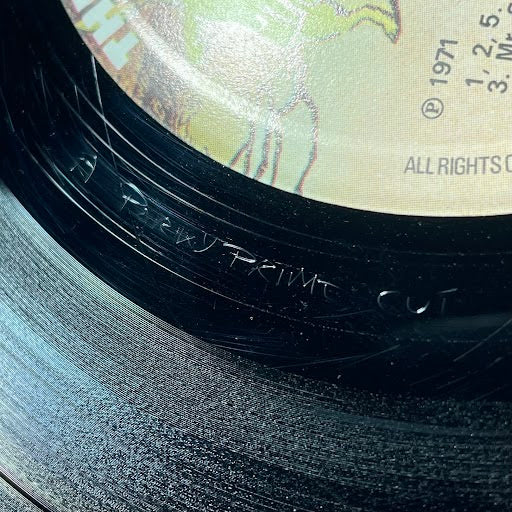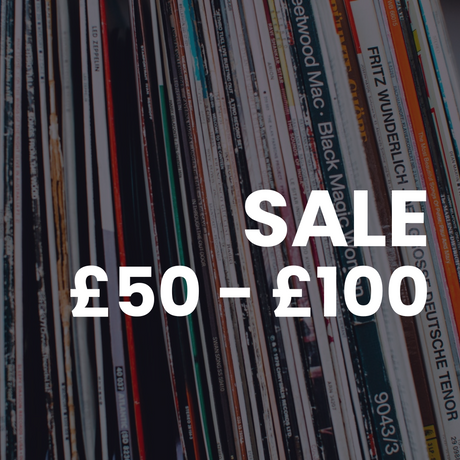Determining if a Beatles record is a first pressing (also referred to as a "first press" or "first edition") can be a complex process, as it often involves examining various details such as label variations, matrix numbers, cover details, and other specific characteristics.
Keep reading to learn more about how you can identify your Beatles records.
Introducing The Beatles
In the annals of music history, few names resonate as much as The Beatles. Their tunes have been woven into the fabric of our culture, leaving a mark that continues to captivate listeners across generations.
From the charm of "Please Please Me" to the revolutionary sounds of "Abbey Road," each Beatles album is an iconic reflection of the pivotal time they were released. The evolution of Parlophone record labels accompanied the band's artistic growth, reflecting the changing times and technologies that shaped their career. As enthusiasts and collectors, being able to decipher these labels reveals a wealth of information about the pressing, release year, and potential rarity.
This guide aims to equip you with the tools to identify and understand the different versions of these iconic records.
More Detailed Research
If you’re looking for incredibly specific guidance in order to pin down a specific release, we would recommend any one of a huge number of websites that document this.
and of course, Discogs.
1. Black and Gold Label (1962-1963)
The earliest Beatles releases on Parlophone featured a black label with gold text. This design was used for their debut album "Please Please Me” and the label displayed the Parlophone logo and the band's name in gold lettering.
This record was first released during a transitionary period for Parlophone, which is why only the first and second pressings of this record feature the gold and black design. Everything soon afterwards, for this record and their other releases, features probably their most recognisable record design…


2. Yellow and Black Label (1963-1969)
Perhaps the most iconic of all Beatles labels, this design featured a yellow label with black text. This label design accompanied numerous classic albums, including "Beatles for Sale," "Rubber Soul," "Revolver," "Sgt. Pepper's Lonely Hearts Club Band," and more. This design became synonymous with the Beatles' mid-career period.


You can be confident that if you remove a Beatles record from its sleeve and it has a yellow Parlophone logo, the record will be worth a good bit of money. Even once you’ve seen that it has this logo, your work identifying the record doesn’t stop there.
Shop The Beatles At Atlas Records
Matrix Etchings
The first step is to get down the matrix numbers, which will generally be something like “XEX481-3N.” If you’d like to learn more about matrix numbers, check out our blog about identifying a first press or our blog about what matrix etchings mean.
A prime example of where this becomes important in narrowing down your selection is “Rubber Soul” (first released Dec 1965). Some of the earliest (but not the very first) pressings are a ‘Loud Cut’ version, which had the matrix numbers XEX 579-1 and XEX 580-1. Here, the -1 is the important bit.

Details On The Sleeve
Beyond the matrix numbers, the next things that need checking are details like who printed the sleeve (eg, Garrod & Lofthouse or Ernest J. Day) and the font style on the label itself (Serif, Sans Serif, Times New Roman…)
After this, you get down to the real details of that specific release. Some albums might feature errors on the first press which were corrected further down the line, such as a change in writing credits or even a spelling mistake. There will also be details like the alignment of text on the label – where does it say ‘Made in Gt. Britain’… or does it even say it at all? As well as the sites mentioned earlier on in this article, Discogs is an utterly invaluable tool to use for identifying your record releases.
This black and yellow label design was in use until 1969, which conveniently covers pretty much all of the earliest versions of The Beatles albums, with only two of them (Abbey Road & Let It Be) having been released after this, in September 1969 and May 1970 respectively. This meant that the first versions of these records featured the ‘Apple’ label.
3. Apple Label (1969-1970)
As the Beatles transitioned into their later years, the label design changed to feature the iconic Apple logo. This design marked the release of albums like "Abbey Road" and "Let It Be." The label now incorporated the Apple logo into the design, filling the entire label with the outside of an apple on the front, and the inside on the back.


The Beatles' transition to using the Apple logo in 1969 was closely tied to their desire for more control over their business affairs and creative endeavours. The creation of Apple Corps Ltd., a multimedia company, marked their attempt to explore new horizons beyond just music. The business was also formed in an attempt to bring their enterprises together for tax purposes, and is one of the earliest examples of an artist backed music industry startup.
The Apple subsidiaries included Apple Electronics, Apple Films, Apple Publishing, Apple Retail and Apple Studio. Oh, and yes – Apple Records did indeed file a suit against Apple Computer for trademark infringement, back in 1978. The suit was settled with a payment of $80,000, and Apple Computer agreed to stay out of the music business.


4. Black and Silver Labels (Mid 1969 onwards)
In the later years, Parlophone and EMI released various reissues of The Beatles' albums on vinyl. These reissues often featured updated label designs, commonly known as the "Parlophone EMI box" labels. These labels were created for reissuing purposes and aimed to capture the spirit of the original label designs while incorporating modern printing techniques.
These reissues are worth a fraction of the value of the original black and yellow pressings but are a good place to look if you want to find the albums in fantastic condition and for a reasonable price. If you’re just here to listen to music, it’s the perfect option.


5. Other Label Designs
It's essential to recognise the multitude of label variations that extend beyond our discussion. The Beatles' global influence prompted diverse label designs across different countries. From the UK designs we’ve mentioned in this blog post to the United States, from Japan to Germany, from Australia to Brazil, each locale contributed its unique label variants, reflecting cultural nuances.
As collectors, enthusiasts, and fans, our understanding of these label designs contributes to a richer connection with the music and history of The Beatles. These labels encapsulate the band's growth, experimentation, and the enduring impact of their music. Whether you're examining the fonts, catalogue numbers, or colour schemes, each label tells a unique story.










5 comments
Hi, I have been offered The Beatles’ White Album (PMC 7067/8) for £450. It has all the original features/enclosures e.g. top laoder, four postcards, poster and two black inner sleeves (slightly worn at edges). The outer cover has been slightly discoloured but is intact. The two LPs are VG+ I’m told and the album number is #2072. Can any knowleagble person perhaps tell me how much I should be prepared to pay for such a sought after album. Many thanks. Calvin
hi there
I have a white album very low number 10 with a large grey dot in front of the number ?
hoping you can help
regards
rico
I have Rubber Soul.
Yellow and Black label. Garrod & Lofthouse printers. Laminated. Font on label is Times New Roman.
YEX178-2 GG 3
YEX179-2 RP 3
Sleeve is VG+ if not NM
Record has crackles etc, and skips on tracks A2-A4. Other than that it is VG+ at least.
I know it’s a 1st press, but I understand that the letters GG denote how early a first press. Anyone know?
Any idea of price, given the condition? I paid £2 for it!
I will buy it from you for $1,200.
I was wondering g how to be 100 percent positive I have a Beatles white album 1st pressing and get info on creditable buyers